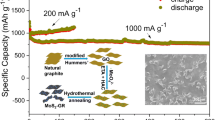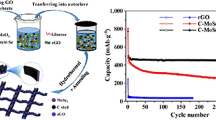Abstract
Two-dimensional (2D) molybdenum disulfide (MoS2) holds significant promise as an energy storage material, whereas the exfoliation of MoS2 into few-layer from natural molybdenites remains a challenge. An efficient electrochemical strategy was proposed for the preparation of few-layer MoS2 through cationic intercalation. Few-layer MoS2 without the impurity phases was obtained with high yield through Raman mapping analysis, and the intermediate (TBA+)xMoS2x− was captured by in-situ Raman. Note that the charge transport kinetics of the exfoliated few-layer MoS2 was further enhanced by the introduction of graphene, which could efficiently enhance the Na+ diffusion mobility, alleviate the volume change of MoS2 and stabilize the reaction products. Commendably, the exfoliated MoS2/graphene hybrid shows a reversible specific capacity of 642.8 mA h g−1 at 0.1 A g−1, superior rate performance (447.8 and 361.9 mA h g−1 at 1 and 5 A g−1, respectively) and remarkable long-cycle stability with 328.7 mA h g−1 at 1 A g−1 after 1000 cycles for sodium-ion batteries (SIBs). Therefore, this efficient electrochemical exfoliation method can be driven to prepare other few-layer 2D materials for SIBs.
摘要
二维结构的二硫化钼(MoS2)是一种很有前景的储能材料, 然而从天然辉钼矿中剥离出少片层的二硫化钼层仍是一个难题. 本文提出了一种有效的电化学阳离子插层制备少片层MoS2的策略. 通过原位拉曼捕获电化学插层过程中的中间产物(TBA+)xMoS2x−, 拉曼映射分析结果表明获得了具有高产率和无相变的少片层MoS2. 值得注意的是, 石墨烯的引入进一步增强了剥离的少片层MoS2的电荷迁移动力学, 可以有效增强钠离子的扩散迁移率, 缓解MoS2在充放电过程中的体积变化以及稳定反应产物. E-MoS2/graphene 作为钠离子电池负极材料, 其可逆比容量为642.8 mA h g−1 (@0.1 A g−1), 并表现出优异的倍率性能(比容量分别为447.8和361.9 mA h g−1@1和5 A g−1)以及卓越的长周期循环稳定性, 在1 A g−1 的电流密度下, 1000次循环后的可逆比容量为328.7 mA h g−1. 这种 高效的电化学剥离方法也可用于制备其他二维少片层钠离子电池电极材料.
Similar content being viewed by others
References
Ren J, Teng C, Cai Z, et al. Controlled one step thinning and doping of two-dimensional transition metal dichalcogenides. Sci China Mater, 2019, 62: 1837–1845
Zhang XJ, Su FZ, Chen DM, et al. A water-stable EuIII-based MOF as a dual-emission luminescent sensor for discriminative detection of nitroaromatic pollutants. Dalton Trans, 2019, 48: 1843–1849
He H, Chen C, Chen Z, et al. Ni3S2@S-carbon nanotubes synthesized using NiS2 as sulfur source and precursor for high performance sodium-ion half/full cells. Sci China Mater, 2020, 63: 216–228
Shi D, Zheng R, Liu CS, et al. Dual-functionalized mixed Keggin- and Lindqvist-type Cu24-based POM@MOF for visible-light-driven H2 and O2 evolution. Inorg Chem, 2019, 58: 7229–7235
Gong X, Liu Y, Xiang H, et al. Membraneless reproducible MoS2 field-effect transistor biosensor for high sensitive and selective detection of FGF21. Sci China Mater, 2019, 62: 1479–1487
Shi D, Zheng R, Sun MJ, et al. Semiconductive copper(I)-organic frameworks for efficient light-driven hydrogen generation without additional photosensitizers and cocatalysts. Angew Chem Int Ed, 2017, 56: 14637–14641
Bai G, Lyu Y, Wu Z, et al. Lanthanide near-infrared emission and energy transfer in layered WS2/MoS2 heterostructure. Sci China Mater, 2020, 63: 575–581
Li Z, Liu S, Vinayan BP, et al. Hetero-layered MoS2/C composites enabling ultrafast and durable Na storage. Energy Storage Mater, 2019, 21: 115–123
Hou M, Qiu Y, Yan G, et al. Aging mechanism of MoS2 nanosheets confined in N-doped mesoporous carbon spheres for sodium-ion batteries. Nano Energy, 2019, 62: 299–309
Pan Q, Zhang Q, Zheng F, et al. Construction of MoS2/C hierarchical tubular heterostructures for high-performance sodium ion batteries. ACS Nano, 2018, 12: 12578–12586
Wang G, Bi X, Yue H, et al. Sacrificial template synthesis of hollow C@MoS2@PPy nanocomposites as anodes for enhanced sodium storage performance. Nano Energy, 2019, 60: 362–370
Eda G, Yamaguchi H, Voiry D, et al. Photoluminescence from chemically exfoliated MoS2. Nano Lett, 2011, 11: 5111–5116
Wu N, Shen J, Sun L, et al. Hierarchical N-doped graphene coated 1D cobalt oxide microrods for robust and fast lithium storage at elevated temperature. Electrochim Acta, 2019, 310: 70–77
Zhang Y, Tao H, Li T, et al. Vertically oxygen-incorporated MoS2 nanosheets coated on carbon fibers for sodium-ion batteries. ACS Appl Mater Interfaces, 2018, 10: 35206–35215
Chen DM, Sun CX, Liu CS, et al. Stable layered semiconductive Cu (I)-organic framework for efficient visible-light-driven Cr(VI) reduction and H2 evolution. Inorg Chem, 2018, 57: 7975–7981
Radisavljevic B, Radenovic A, Brivio J, et al. Single-layer MoS2 transistors. Nat Nanotech, 2011, 6: 147–150
Coleman JN, Lotya M, O’Neill A, et al. Two-dimensional nanosheets produced by liquid exfoliation of layered materials. Science, 2011, 331: 568–571
Smith RJ, King PJ, Lotya M, et al. Large-scale exfoliation of inorganic layered compounds in aqueous surfactant solutions. Adv Mater, 2011, 23: 3944–3948
Xu F, Si XJ, Song YY, et al. Palladium-catalyzed C-N bond cleavage of 2H-azirines for the synthesis of functionalized α-amido ketones. J Org Chem, 2019, 84: 2200–2208
Li Y, Duerloo KAN, Wauson K, et al. Structural semiconductor-to-semimetal phase transition in two-dimensional materials induced by electrostatic gating. Nat Commun, 2016, 7: 10671
Yang S, Brüller S, Wu ZS, et al. Organic radical-assisted electrochemical exfoliation for the scalable production of high-quality graphene. J Am Chem Soc, 2015, 137: 13927–13932
Huang Z, Hou H, Zhang Y, et al. Layer-tunable phosphorene modulated by the cation insertion rate as a sodium-storage anode. Adv Mater, 2017, 29: 1702372
Shuai H, Ge P, Hong W, et al. Electrochemically exfoliated phosphorene-graphene hybrid for sodium-ion batteries. Small Methods, 2018, 3: 1800328
Ambrosi A, Sofer Z, Luxa J, et al. Exfoliation of layered topological insulators Bi2Se3 and Bi2Te3via electrochemistry. ACS Nano, 2016, 10: 11442–11448
Leong SX, Mayorga-Martinez CC, Chia X, et al. 2H → 1T phase change in direct synthesis of WS2 nanosheets via solution-based electrochemical exfoliation and their catalytic properties. ACS Appl Mater Interfaces, 2017, 9: 26350–26356
Xie X, Ao Z, Su D, et al. MoS2/graphene composite anodes with enhanced performance for sodium-ion batteries: the role of the two-dimensional heterointerface. Adv Funct Mater, 2015, 25: 1393–1403
Wu N, Qiao X, Shen J, et al. Anatase inverse opal TiO2-x@N-doped C induced the dominant pseudocapacitive effect for durable and fast lithium/sodium storage. Electrochim Acta, 2019, 299: 540–548
Lin Z, Liu Y, Halim U, et al. Solution-processable 2D semiconductors for high-performance large-area electronics. Nature, 2018, 562: 254–258
Wu N, Miao D, Zhou X, et al. V3S4 nanosheets anchored on N, S co-doped graphene with pseudocapacitive effect for fast and durable lithium storage. Nanomaterials, 2019, 9: 1638
Li G, Luo D, Wang X, et al. Enhanced reversible sodium-ion intercalation by synergistic coupling of few-layered MoS2 and S-doped graphene. Adv Funct Mater, 2017, 27: 1702562
Xie J, Zhang J, Li S, et al. Controllable disorder engineering in oxygen-incorporated MoS2 ultrathin nanosheets for efficient hydrogen evolution. J Am Chem Soc, 2013, 135: 17881–17888
Liu Q, Li X, He Q, et al. Gram-scale aqueous synthesis of stable few-layered 1T-MoS2: applications for visible-light-driven photocatalytic hydrogen evolution. Small, 2015, 11: 5556–5564
David L, Bhandavat R, Singh G. MoS2/graphene composite paper for sodium-ion battery electrodes. ACS Nano, 2014, 8: 1759–1770
Lee C, Yan H, Brus LE, et al. Anomalous lattice vibrations of single- and few-layer MoS2. ACS Nano, 2010, 4: 2695–2700
Otoyama M, Ito Y, Hayashi A, et al. Raman imaging for LiCoO2 composite positive electrodes in all-solid-state lithium batteries using Li2S-P2S5 solid electrolytes. J Power Sources, 2016, 302: 419–425
Kataria S, Patsha A, Dhara S, et al. Raman imaging on high-quality graphene grown by hot-filament chemical vapor deposition. J Raman Spectrosc, 2012, 43: 1864–1867
Chakraborty B, Matte HSSR, Sood AK, et al. Layer-dependent resonant Raman scattering of a few layer MoS2. J Raman Spectrosc, 2013, 44: 92–96
González JR, Alcántara R, Tirado JL, et al. Electrochemical interaction of few-layer molybdenum disulfide composites vs. sodium: new insights on the reaction mechanism. Chem Mater, 2017, 29: 5886–5895
Yu L, Yang JF, Guan BY, et al. Cover picture: hierarchical hollow nanoprisms based on ultrathin Ni-Fe layered double hydroxide nanosheets with enhanced electrocatalytic activity towards oxygen evolution. Angew Chem Int Ed, 2018, 57: 1
Ejigu A, Kinloch IA, Dryfe RAW. Single stage simultaneous electrochemical exfoliation and functionalization of graphene. ACS Appl Mater Interfaces, 2017, 9: 710–721
Ebert LB. Intercalation compounds of graphite. Annu Rev Mater Sci, 1976, 6: 181–211
Wu N, Du W, Gao X, et al. Hollow SnO2 nanospheres with oxygen vacancies entrapped by a N-doped graphene network as robust anode materials for lithium-ion batteries. Nanoscale, 2018, 10: 11460–11466
Greczynski G, Hultman L. X-ray photoelectron spectroscopy: Towards reliable binding energy referencing. Prog Mater Sci, 2020, 107: 100591
Xie X, Makaryan T, Zhao M, et al. MoS2 nanosheets vertically aligned on carbon paper: A freestanding electrode for highly reversible sodium-ion batteries. Adv Energy Mater, 2016, 6: 1502161
Ren W, Zhang H, Guan C, et al. Ultrathin MoS2 nanosheets@metal organic framework-derived N-doped carbon nanowall arrays as sodium ion battery anode with superior cycling life and rate capability. Adv Funct Mater, 2017, 27: 1702116
Lin M, Deng M, Zhou C, et al. Popcorn derived carbon enhances the cyclic stability of MoS2 as an anode material for sodium-ion batteries. Electrochim Acta, 2019, 309: 25–33
Zhang K, Li P, Guo S, et al. An ¥ngström-level d-spacing controlling synthetic route for MoS2 towards stable intercalation of sodium ions. J Mater Chem A, 2018, 6: 22513–22518
Wu N, Tian W, Shen J, et al. Facile fabrication of a jarosite ultrathin KFe3(SO4)2(OH)6@rGO nanosheet hybrid composite with pseudocapacitive contribution as a robust anode for lithium-ion batteries. Inorg Chem Front, 2019, 6: 192–198
Shuai H, Li J, Hong W, et al. Electrochemically modulated LiNi1/3Mn1/3Co1/3 O2 cathodes for lithium-ion batteries. Small Methods, 2019, 3: 1900065
Acknowledgements
This work was supported by the National Natural Science Foundation of China (51622406, 21673298, and 21473258), the National Key Research and Development Program of China (2017YFB0102000 and 2018YFB0104200) and the Project of Innovation Driven Plan in Central South University (2017CX004 and 2018CX005).
Author information
Authors and Affiliations
Contributions
Author contributions Shuai H conceived the idea, carried out the experiments, material characterizations and electrochemical measurements, and wrote the paper under the guidance from Ji X. Li J and Zhang X conducted the in-situ Raman characterization. Jiang F and Sun W offered the pristine molybdenite bulk. Xu L and Hu J conducted the XRD characterization. Duan H and Hu J gave pivotal advice. Hou H and Zou G assisted in the date analysis. All authors discussed the results and commented on the manuscript.
Corresponding author
Ethics declarations
Conflict of interest The authors declare that they have no conflict of interest.
Additional information
Honglei Shuai received his Master degree from Xinyang Normal University in 2017. He is currently working toward a PhD degree at Central South University and his current research focuses on the energy storage materials and devices through electrochemical methods.
Xiaobo Ji is a “Shenghua” Professor at Central South University and a Fellow of the Royal Society of Chemistry, specializing in the research and development of batteries and supercapacitor materials and their systems. He received his PhD in electrochemistry in 2007 under the supervision of Prof. Richard Compton at the University of Oxford and undertook postdoctoral work at MIT with Prof. Donald Sadoway.
Supporting Information
40843_2020_1347_MOESM1_ESM.pdf
Electrochemically intercalated intermediate induced exfoliation of few-layer MoS2 from molybdenite for long-life sodium storage
Rights and permissions
About this article
Cite this article
Shuai, H., Li, J., Jiang, F. et al. Electrochemically intercalated intermediate induced exfoliation of few-layer MoS2 from molybdenite for long-life sodium storage. Sci. China Mater. 64, 115–127 (2021). https://doi.org/10.1007/s40843-020-1347-5
Received:
Accepted:
Published:
Issue Date:
DOI: https://doi.org/10.1007/s40843-020-1347-5




